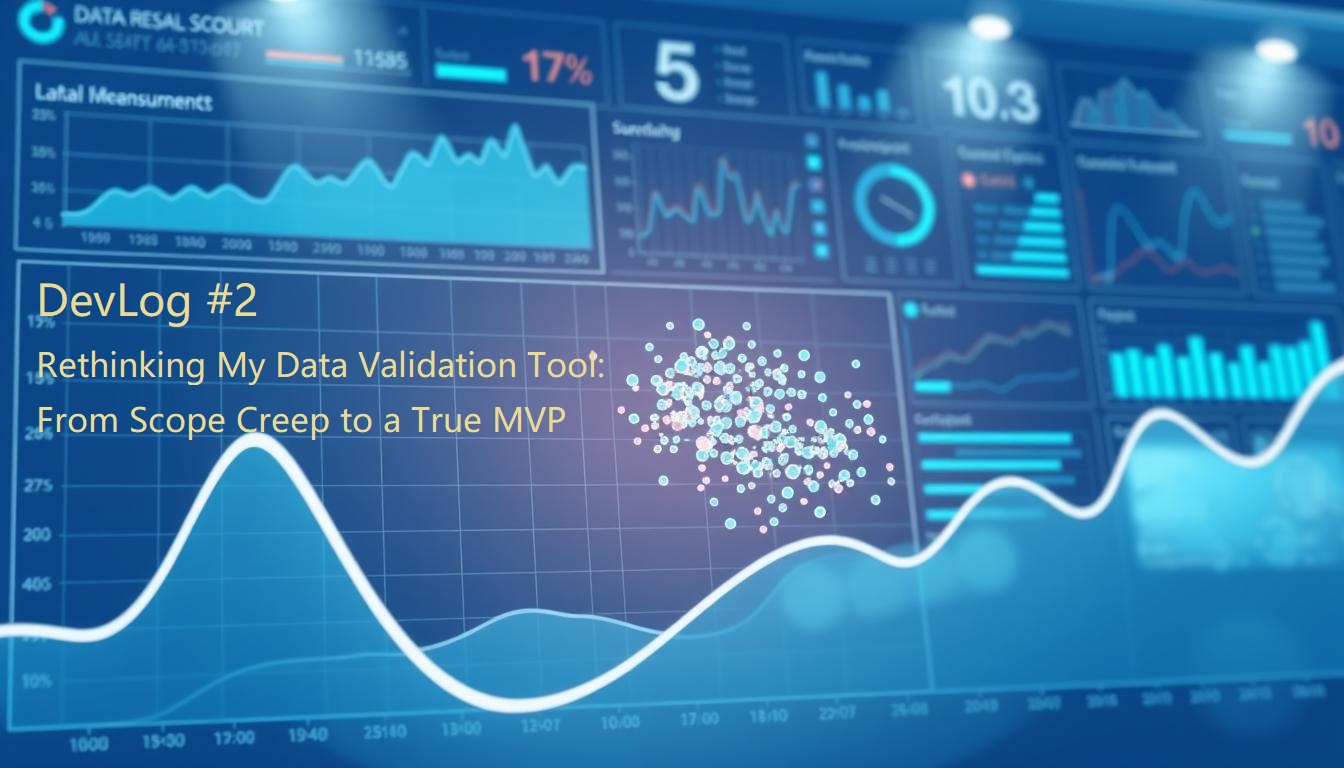DevLog#2: Why I Scrapped My Half-Built Data Validation Platform
A data architect's honest account of scrapping a half-built data validation platform to build what users actually want: a lightweight Python CLI tool.
Update (2025-08-06): ValidateLite is now open source and released. GitHub: litedatum/validatelite. Install via PyPI:
pip install validatelite, then runvlite --help.
From Ambition to Simplicity: The Origin of This Data Validation Tool
Sometimes the hardest part of building a product isn’t the coding—it’s knowing when to stop and ask: “Am I building the right thing?”
Two months ago, I was deep in the trenches of ValidateLite, my data validation tool, convinced I was 70% done. I had a sleek WebUI, metadata management, and a FastAPI backend. Everything looked promising on paper. Then I stumbled across a Reddit post that changed everything.
The Wake-Up Call
A frustrated developer was complaining about Great Expectations: “Too complex, too many dependencies. I don’t want a ‘data quality platform’—I want a ‘data validation function’.”
That hit me like a cold shower. Here I was, building exactly what this person didn’t want.
Why Build a Data Validation Tool?
As a seasoned data architect who’d led Java-based data quality tools before, I thought I understood the problem. Python data validation seemed straightforward enough. With AI pair programming on the rise, why not leverage my domain knowledge and let AI handle the coding gaps?
My initial vision was ambitious: a WebUI-based tool with metadata configuration, connection management, rule execution, and result visualization. I chose Streamlit for the frontend and FastAPI for the backend, aiming for something lightweight yet comprehensive.
But “lightweight” quickly became anything but.
Why It Went Wrong
After two months of development, I realized I’d made four critical mistakes:
-
Unclear requirements - I had a PRD but no detailed functional specs. AI filled the gaps by expanding features I never asked for.
-
Vague design - Especially around API interfaces, leading to two painful refactors mid-development.
-
Overestimating AI capabilities - I lacked experience in driving AI for app development, despite my software engineering background.
-
Perfectionism killing the MVP - I added complex features like multi-rule execution for single tables and obsessed over test coverage.
The scope creep was real. I’d drifted far from my Minimum Viable Product goals.
The Four Questions That Changed Everything
That Reddit post forced me to ask myself some uncomfortable questions:
- Does my product really need to maintain a metadata layer?
- Is my core engine small and beautiful enough to support different deployment scenarios?
- Is WebUI actually necessary for my target users?
- What’s the most valuable part of my product, and is it truly at the center?
Once I asked the right questions, the answers became painfully obvious. My target audience—data engineers and analysts—didn’t want another platform. They wanted a tool that could validate data with a single command, SQL query, or script.
The Great Pivot
I made a tough decision: scrap the half-built WebUI version and extract the rule engine as a standalone CLI tool.
But there was a problem. The rule engine was tightly coupled with other modules, especially through ORM models designed for metadata persistence. This violated basic DDD principles I knew by heart but had somehow ignored in practice.
“Technical debt must be paid. I couldn’t justify keeping legacy code just to maintain backward compatibility.”
I redesigned the interface using a clean schema model in a shared module, refactored twice to internalize configuration management and error handling, and finally achieved a truly independent core module.
Building an App with Python: Lessons Learned
Working on this Python app development project taught me that domain expertise doesn’t automatically translate to implementation wisdom. When I lacked confidence in Python project structure, I defaulted to AI suggestions—not always the best approach.
The refactoring process was painful but necessary. I couldn’t manage technical debt by pushing it to future versions. Clean architecture isn’t just academic theory; it’s survival for any product that plans to evolve.
Now I have a completed CLI module with comprehensive tests, and the first version has been released on GitHub and PyPI. The journey from bloated platform to focused tool has been humbling but educational. See: ValidateLite on GitHub.
What’s Next for the data validation tool
The new ValidateLite embodies everything I originally wanted: lightweight Python data validation that gets you started in 30 seconds. No complex setups, no YAML configuration files, just straightforward data quality checks.
Key features in the pipeline:
- Pydantic-powered schema validation
- CLI-first design for developer workflows
- Minimal dependencies and fast startup
- Extensible rule engine architecture
Quick Start (Current)
1
2
pip install validatelite
vlite check --conn data.csv --table data --rule "not_null(id)" --rule "unique(email)"
The Real Lessons
Two key takeaways from this experience:
Product direction trumps technical execution. You can build the most elegant code, but if you’re solving the wrong problem, it’s worthless. I thought I was building for data engineers, but I was actually building for platform administrators.
Complete requirements and design are non-negotiable. AI pair programming is powerful, but it amplifies both good and bad decisions. Without clear specifications, AI will gladly help you build the wrong thing very efficiently.
These lessons aren’t just about data validation tools—they apply to any technical product development. Sometimes the best code you can write is the code you delete.
